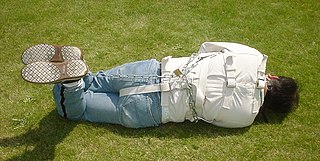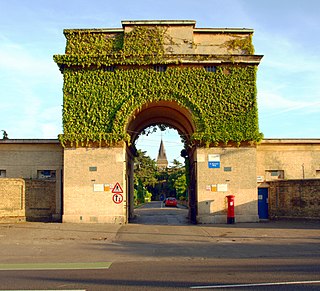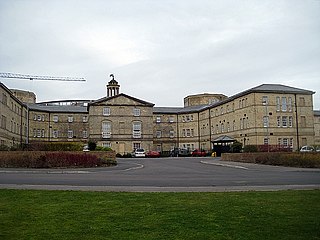
Psychiatric hospitals, also known as mental health hospitals, or behavioral health hospitals are hospitals or wards specializing in the treatment of severe mental disorders, including schizophrenia, bipolar disorder, eating disorders, dissociative identity disorder, major depressive disorder, and others.

Physical restraint refers to means of purposely limiting or obstructing the freedom of a person's bodily movement.

A straitjacket is a garment shaped like a jacket with long sleeves that surpass the tips of the wearer's fingers. Its most typical use is restraining people who may cause harm to themselves or others. Once the wearer slides their arms into the sleeves, the person restraining the wearer crosses the sleeves against the chest and ties the ends of the sleeves to the back of the jacket, ensuring the arms are close to the chest with as little movement as possible.

Ashworth Hospital is a high-security psychiatric hospital in Maghull, 10 miles (16 km) northeast of Liverpool. It is a part of Mersey Care NHS Foundation Trust, catering to patients with psychiatric health needs that require treatment in conditions of high security.
Medical restraints are physical restraints used during certain medical procedures to restrain patients with (supposedly) the minimum of discomfort and pain and to prevent them from injuring themselves or others.
Suicide watch is an intensive monitoring process used to ensure that any person cannot attempt suicide. Usually the term is used in reference to inmates or patients in a prison, hospital, psychiatric hospital or military base. People are placed on suicide watch when it is believed that they exhibit warning signs indicating that they may be at risk of committing bodily harm or purposefully killing themselves.

St Bernard's Hospital, also known as Hanwell Insane Asylum and the Hanwell Pauper and Lunatic Asylum, was an asylum built for the pauper insane, opening as the First Middlesex County Asylum in 1831. Some of the original buildings are now part of the headquarters for the West London Mental Health NHS Trust (WLMHT).
St Andrew's Healthcare is a large independent charity based at St Andrew's Hospital in Northampton, which provides psychiatric services. It also has sites in Essex, Birmingham and Nottinghamshire. It runs specialist services for adolescents, men, women and older people with mental illness, learning disability, brain injury, autism and dementia and hosts the National Brain Injury Centre. It is a psychiatric hospital and service provider that caters for individuals requiring inpatient care and rehabilitation, and step-down housing.
The Huntercombe Group is a specialist health provider in the United Kingdom specialising in the Child and Adolescent Mental Health Services (CAMHS), Adult Mental Health, Brain Injury Rehabilitation and Neurological Care Centre, Adult Learning Disability and Children's Complex Needs. It operates 12 hospitals and specialist centres located throughout England and Scotland.
Rogers v. Okin was a landmark case in which the United States Court of Appeals for the First Circuit considered whether a person diagnosed with mental illness committed to a state psychiatric facility and assumed to be competent, has the right to make treatment decisions in non-emergency conditions.

Vincenzo Chiarugi (1759–1820) was an Italian physician who helped introduce humanitarian reforms to the psychiatric hospital care of people with mental disorders. His early part in a movement towards moral treatment was relatively overlooked until a gradual reassessment through the 20th century left his reforms described as a landmark in the history of psychiatry. He also specialized in dermatology and wrote on other subjects.
Bridgewater State Hospital, located in southeastern Massachusetts, is a state facility housing the criminally insane and those whose sanity is being evaluated for the criminal justice system. It was established in 1855 as an almshouse. It was then used as a workhouse for inmates with short sentences who worked the surrounding farmland. It was later rebuilt in the 1880s and again in 1974. As of January 6, 2020 there were 217 inmates in general population beds. The facility was the subject of the 1967 documentary Titicut Follies. Bridgewater State Hospital falls under the jurisdiction of the Massachusetts Department of Correction but its day to day operations is managed by Wellpath, a contracted vendor.
Workplace safety in healthcare settings is similar to the workplace safety concerns in most occupations, but there are some unique risk factors, such as chemical exposures, and the distribution of injuries is somewhat different from the average of all occupations. Injuries to workers in healthcare settings usually involve overexertion or falling, such as strained muscles from lifting a patient or slipping on a wet floor. There is a higher than average risk of violence from other people, and a lower than average risk of transportation-related injuries.

The Stanley Royd Hospital, earlier named the West Riding Pauper Lunatic Asylum, was a mental health facility in Wakefield, West Yorkshire. It was managed by the Wakefield and Pontefract Community Health NHS Trust.
The Keeping All Students Safe Act or KASSA is designed to protect children from the abuse of restraint and seclusion in school. The first Congressional bill was introduced in the United States House of Representatives on December 9, 2007, and named the Preventing Harmful Restraint and Seclusion in Schools Act. The primary sponsors of the two bills are Senator Tom Harkin (D-IA), Chair of the Senate Health, Education, Labor, and Pensions Committee, Congressman George Miller (D-CA), Ranking Member of the House Education and Workforce Committee, and Congressman Gregg Harper (R-MS).

St Andrews Hospital is a mental health facility in Northampton, England. It is managed by St Andrew's Healthcare.
The Mental Patients' Union was an activist organisation founded in March 1973 in Paddington Day Hospital. Some of the founders had previously been members of the Scottish Union of Mental Patients.

Olaseni Lewis, a 23-year-old British man, died on 3 September 2010 at Bethlem Royal Hospital in London, United Kingdom, after police subjected him to prolonged physical restraint. Lewis had voluntarily sought care following the onset of acute mental health issues and died from cerebral hypoxia soon after, following actions that involved eleven officers of London's Metropolitan Police. After seven years of campaigning by Lewis' family and two inquiries by the Independent Police Complaints Commission (IPCC), a second coroners' inquiry was raised.

Restraint and seclusion is a highly controversial practice in the special education system involving holding students down physicaly or involuntarily locking students in seclusion rooms. In United States public schools, the practices of restraint and seclusion are not regulated on the federal level. All but four of the 50 U.S. states have regulations on portions of these practices.
The abuse in special education usually refers to the use of restraint and seclusion, but can also refer to students being threatened with violence or staff withholding food. This abuse often leaves students with trauma and can leave the parents feeling guilt for the abuse.











